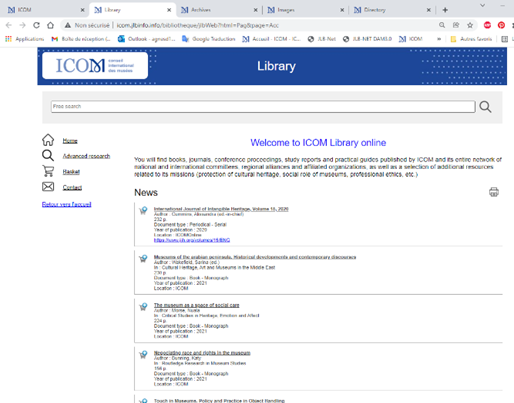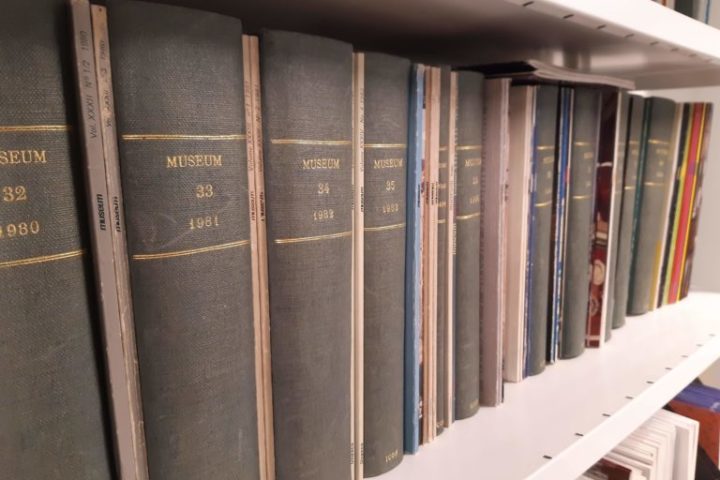We are proud to announce the launch of ICOM’s Online Library, which contains almost 45,000 references to notices, publications, activity reports and photographs. For the occasion, we interviewed Agnès Roché, ICOM documentalist-archivist, to tell us more about the history of this documentary fund and its functioning at the service of ICOM members.
Agnès Roché, you have been a documentalist-archivist at ICOM for two years. You work on a documentary collection that was created in 1948, shortly after the creation of ICOM in 1946. Can you outline the history of this collection?
From the outset, the founders of ICOM wanted to create a resource centre specialising in museums and museology, with a twofold objective: to bring together all the documentation available on the subject and to make it available to museum professionals. Thanks to the contributions of ICOM members, the centre’s collections were rapidly expanded.
In the early 1980s, the Documentation Centre created its first computerised bibliographic database using the open source software CDS-ISIS (later Winisis) developed for UNESCO. A few years later, in 1989, all handwritten records prior to 1981 were integrated into this database to make the computerised catalogue complete.
At the beginning of the 1990s, the production of documents in the museum field had greatly increased, other resource centres had been created, such as the ICCROM library in the field of conservation-restoration, and the development of the Internet was opening up new prospects for access to information. It was then decided that the documentation centre would henceforth give priority to the publications of ICOM and its network of national and international committees and regional alliances. A large part of the museum collection accumulated up to then, consisting of “non-ICOM” publications, was then deposited in two partner institutions: the Ecole Nationale Supérieure des Beaux-Arts (ENSBA) received exhibition catalogues, and the Direction des Musées de France (now the Service des Musées de France) received museum catalogues, literature and specialised journals. In the current database, the location of each referenced document is specified.
The centre nevertheless preserves its collections of museum directories, national legislative and regulatory texts, and a selection of documents related to its programmes and missions: protection of endangered heritage, fight against illicit trafficking, museum ethics, etc.
In 2015, the ICOM archives will be the subject of a major sorting and classification campaign for the first time, covering the period from 1946 to 2007.
When you arrived, you took charge of an important project: offering an online document platform while continuing the digitisation of documents. Can you tell us more about this?
At the beginning of 2020, the Winisis software that hosted the document database was no longer updated and its operating system was obsolete.
The acquisition of a new full web documentary database management software has made it possible not only to safeguard the entire historical database during ICOM’s move from UNESCO headquarters to rue Lasson (Paris 12è), but also and above all to adapt it to the needs of its users today. In 2022, ICOM has many more members than at its creation in 1946, and they are more than ever spread throughout the world, but the ambition of the documentation centre remains faithful to the intentions of its founders: to put its resources at the service of all museum professionals.
The company JLB-Informatique, publisher of the chosen software, has created an online portal, accessible from the Resources section of the ICOM site, where the entire database can be explored, in simple or advanced search, in the three working languages of ICOM, English, French or Spanish (depending on the language chosen for the browser). In this new version of the database, digital documents and URL links – absent from the previous version – are gradually being associated with the records whenever possible.
In addition to this historical document base, the new software has enabled the creation of new additional databases to highlight ICOM’s previously poorly known archives. The “Archives” database, built from the 2015 inventory, lists the “paper” archives of the ICOM Secretariat and its relations with the committees.
The “Image” database already hosts its collection of posters, scanned in high definition (in particular those of the campaigns and World Museum Days from the 1960s to the present day), and will soon host ICOM’s photographic collection (nearly 5,000 paper prints, slides and negatives from 1950 to the 2000s). While the documentary database is intended to be accessible to as many people as possible, the “Archives” and “Images” databases are reserved exclusively for members, via the members’ area of the website www.icom.museum (under the heading Tools for committees).
In parallel, a campaign to digitise ICOM’s publications and archives, entrusted to the company Arkhênum, specialised in heritage digitisation, has already enabled us to associate a first batch of digital files with the corresponding records in the “Library” and “Archives” databases. A second batch of documents selected in 2021 will soon be added.
ICOM members are naturally invited to contribute to the enrichment of these databases if they have documents that are not yet in the database, or electronic versions of publications that are already referenced!

This service is available to our members. How can I search the database?
The multi-database home page, which can be accessed via the members’ area, and each of the databases in isolation offer a free search space. While this first approach has the advantage of simplicity, the in-depth search offers a more precise choice of fields, accompanied by the corresponding lexicons and tools for refining the results (sorting, filtering by date, keywords, type of document, location, etc.).
The “Online library” section of the site offers some practical advice, and I am of course at the disposal of members to help them with their research. Questions, comments and suggestions are welcome to improve these databases.
What are the prospects for future developments and projects concerning documentation and archives at ICOM?
A thesaurus is being developed for all the databases to improve the quality of indexing. As for the archives, the number of documents to be digitised is considerable, and we ask for the patience and indulgence of ICOM members. In any case, I remain at the disposal of the committees for specific research in the collections kept at the secretariat.
On the homepage of the portal, next to the three databases already mentioned, there is a fourth one, the “Directory” database, with the mention “under construction”. It is an important compilation work, carried out in 2019 by Elisabeth Jani, in charge of documentation at ICOM until December 2020, at the request of the working group on International Committees, which inspired me to create this database, which should bring together, in the form of summary notes, some essential data on the history and missions of ICOM’s bodies, partners and personalities.
